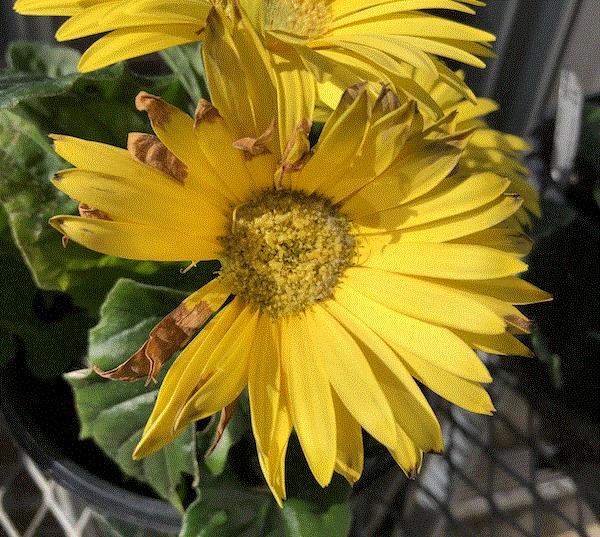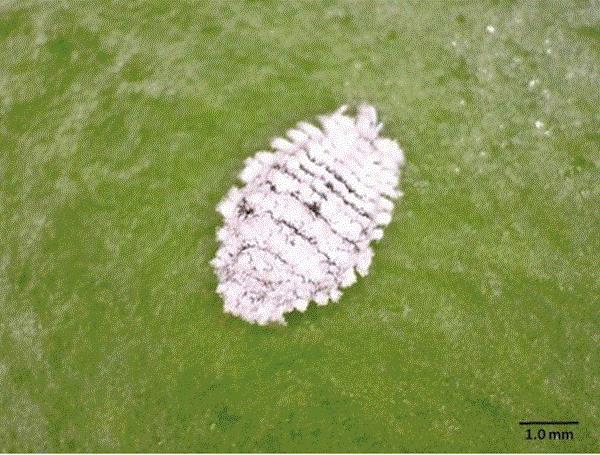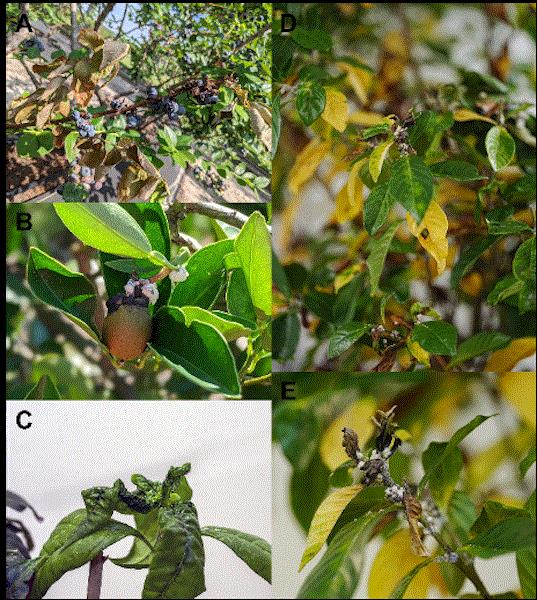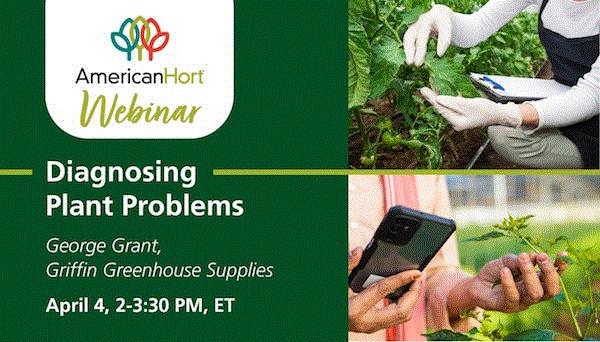More on Phytotoxicity: Symptoms
I told a story about phytotoxicity on gerbera daisy last week. Thanks to David Keller of Express Seed Company, who shared several “horror stories.” Coincidentally, e-GRO also included an article from Nora Catlin of Cornell University Extension on the same topic. Really, y’all, Nora and I didn’t plan twin articles on the same topic.
Nora’s article is a great summary of what you can expect to see and how to prevent phytotoxicity. I can’t beat all the wonderful pictures of symptoms she's included in the article. What I’ll do is to attempt a summary in this week’s newsletter. (Click HERE to check out the article.)

One difficulty of recognizing phytotoxicity is that phytotoxic damage looks very similar to disease symptoms or pest damage. Necrotic spots on a leaf, discoloration or bleaching, or distortion of new growth can be caused by phototoxicity or myriad of other factors. It’s often when diagnoses don’t find any thrips, broad mite, cercospora or other insects, mites or diseases that we begin to wonder if it's phytotoxicity.
Nora provided some tips for recognizing phytotoxicity:
-
The symptoms can range from subtle to obvious
-
There will be patterns, such as:
o The damage may appear where the spray solution had accumulated
o More widespread on the top of the canopy because the upper leaves have shielded the lower leaves from the spray
o More on the edge of a bench or row, where the plants get more of the spray solution
o More often occur on sensitive plants
o Damage may occur on plants of the same age or developmental stage
-
A symptom can appear within a short period of time after pesticide application and the symptom doesn’t spread or develop over time
-
Plants can usually outgrow the damage, i.e., new tissues won't show the same symptom

More on Phytotoxicity: Triggers
So what conditions predispose plants to phytotoxic damage?
Environmental conditions are intimately tied to phytotoxicity. For example, I generally don’t recommend using horticultural oil when the temperature is above 90F or below 40F. High humidity can also be a problem because the spray solution will sit on the foliage longer and has a greater chance of causing damage.
One question I get often is, “If I can’t spray horticultural oil when it’s hot, what can I do if that’s the only thing that works against a pest?” Well, spray early in the morning when the temperature is low and the spray solution has more time to dry. Once the solution dries, the oil residue will have a lower chance of causing damage even if the temperature rises to above 90F later in the day. Light level can also cause damage, either through raising the foliage temperature or reacting with the pesticide itself.
Of course, whether a plant species or cultivar you apply to is sensitive to phytotoxicity or not makes a huge difference. Read pesticide labels carefully because the labels will provide a list of plant species or cultivars that are known to be sensitive to the products. If the label says not to use this product on this plant species or don’t make more than one application or above this rate on that species, you better follow the precautions. (Not to mention the label is the law.) Even if the label doesn’t mention any sensitive plant species or cultivar, it’s a good idea to do a test for phytotoxicity when you use a product on a plant species for the first time.
Plant conditions are also important. Drought-stressed plants are notoriously susceptible to phytotoxicity. But plants that are stressed by disease, insect, frost injury or heat may also be sensitive to one product or another. Stress weakens a plant and the application of a risky product simply adds insult to injury. It’s important to know that phytotoxicity may appear on certain plant parts (such as flowers or bracts) or age (such as soon after transplant), but not on others because of differences in physiology among these parts and ages.
What you use and how you use it also make a difference. Some products have inherently greater risk of causing phytotoxicity than others. For example, herbicides and plant growth regulators work by changing the normal growth and physiology of plants. Copper and sulfur can impact the physiology of pests and plants. Obviously, you’ll need to use these products more carefully. Some formulations (such as oil-based or emulsifiable concentrate) or surfactants can also cause surprising damage.
Years ago, I tested some plant extracts and damage showed up on annual vinca flower (not leaves) within hours of application. It turned out that the surfactant used in that plant extract reacted with light and caused phytotoxicity.
Also, if the application isn’t done properly, part of the crop or plant can be damaged through overdosing. Again, it’s important to read labels on which product is or isn’t safe to use together or tank-mixed before using the products.

I guess, in some way, you can think of phytotoxicity like a disease—its occurrence also depends on the “phytotoxicity triangle.” You’ll need a causal agent (in this case, a pesticide that has formulation or other properties that increases its risk of phytotoxicity), suitable environmental conditions (high temperature, high relative humidity, etc.) and a susceptible plant (either because it's a sensitive plant species or cultivar, or has a condition that predisposes the plant to damage) to tango.
The outcome of the “phytotoxicity triangle” can be drastically different when you change one of the “angles” in this equation. For example, one product may be risky in hot, humid conditions, whereas another product may be more damaging when it's cool and wet. So each combination of plant, product and environmental condition may have to be considered independently and carefully.
I just came up with the “phytotoxicity triangle”! I thought that was pretty clever for an entomologist. To read some good tips on what predisposes a plant to phytotoxicity, click HERE to read Nora’s e-GRO article.

More on Phytotoxicity: Prevention
Lastly, what y’all always want to know: What in the world can you do to prevent phytotoxicity?
Nora’s article also has some tips on that:
-
Read the labels carefully for crop safety, application instructions and cautions on environmental conditions and mixing (including product combination) before application.
-
Do a phytotoxicity test on a small group of plants before broadcasting the application on the entire crop. This step is particularly important if you're using a product or tank mix for the first time or on a crop that isn’t listed as sensitive on the labels. Phytotoxic symptoms usually show up quickly (in one to three days), but you may want to observe the plants for up to seven days before making a broadcast. Remember to have some untreated plants hold in the same conditions so you can compare the symptom and confirm that the damage is indeed phytotoxicity.
-
Apply pesticides under the environmental and plant conditions recommended by the labels.
-
Keep great (not just good) records. This is not only to tell you what went wrong or the conditions that predisposed the plants to damage, but also to remind yourself of the plant species, products and conditions to avoid in the future.

Look Out for the Hibiscus Mealybug
I love mealybugs. Yes, this isn't the first time y’all heard me say that, but I’m going to say it anyway. I jumped at the opportunity to participate when I received an invitation to talk at a symposium on invasive mealybugs at the Southeastern Branch meeting of the Entomological Society of America, held last week in Little Rock, Arkansas.
I talked about my research on the biology and management of striped mealybugs, and used this species as an example how a native mealybug species can spread through the ornamental plant trade. I also learned about another mealybug species—the hibiscus mealybug or lebbeck mealybug (Nipaecoccus viridis)—that we should keep an eye on because this species has been detected on ornamental plants shipped from Florida. Don’t confuse this species with another invasive mealybug, the pink hibiscus mealybug (Maconellicoccus hirsutus), even though the two species has two confusingly similar common names. See—another example of the importance of communicating in species names.

An adult female hibiscus or lebbeck mealybug. She's cute, isn't she? (Photo credit: David Olabiyi, University of Florida.)
The hibiscus mealybug originated from Asia and it’s currently distributed widely in Asia, Oceania and Africa. (For those who aren't familiar with Oceania, this is a geographical region that includes Australia, Papua New Guinea, New Zealand and thousands of islands spanning across the Pacific Ocean, including Hawaii.)
In the United States, the hibiscus mealybug is distributed in central and southern Florida. First found in Florida in 2009, the hibiscus mealybug is becoming a serious pest in citrus and more recently starting to show up on ornamental plants. Between 2010 and 2021, this species has been found on some widely produced and traded ornamental plants, such as gardenia, schefflera, oleander, laurel fig, star jasmine, portulaca and pothos.

A) Infestations of hibiscus mealybug on blueberry; B) citrus; C) papaya; D) gardenia; and E) butterfly weed. (Photo credit: Lauren Diepenbrock and Lance Oborne, University of Florida.)
Most of these infestations on ornamental plants were found in landscapes, but the risk of this mealybug species to spread far and wide is high once it enters the nursery trade. So keep an eye out. The mealybugs are purplish red and turn paper purple when they’re crushed, which is rather distinctive.
Lauren Diepenbrock of the University of Florida’s Citrus Research and Education Center in Lake Alfred, Florida, is leading the research on the hibiscus mealybug. Click HERE for a great review of this species and click HERE for the impact of this species in citrus production.

A Webinar on Diagnosing Plant Problems
AmericanHort is hosting a webinar on "Diagnosing Plant Problems" on April 4, 2:00 to 3:00 p.m. Eastern. The webinar will be presented by George Grant, Technical Specialist Supervisor of Griffin Greenhouse Supplies.
George will guide us through the process of optimizing the information collection process so that diagnosis can be done quickly and correctly. George will be talking about:
-
Building an information checklist so that the most important information are collected properly for accurate problem diagnosis
-
The kind of information that needs to be captured with photographs and how to take these photographs
-
The plant diagnostic process a technical specialist typically goes through so that you can understand what kind of information is important and why

George's webinar is one that's very applicable to what I do. I often receive requests for diagnosis accompanied by incomplete information (e.g., "I don't know the plant species") or out-of-focus pictures. You probably get reports or pictures from scouts that may have the same problems. Knowing the kind of information or picture needed to supply a pest manager or diagnostician will speed up diagnosis, communication and pest management decisions, and avoid costly management mistakes. A win for everyone!
Click HERE to register for the webinar.




See y’all later!

JC Chong
Professor of Entomology at Clemson University
This e-mail received by 27,847 subscribers like you!
If you're interested in advertising on PestTalks contact Kim Brown ASAP!